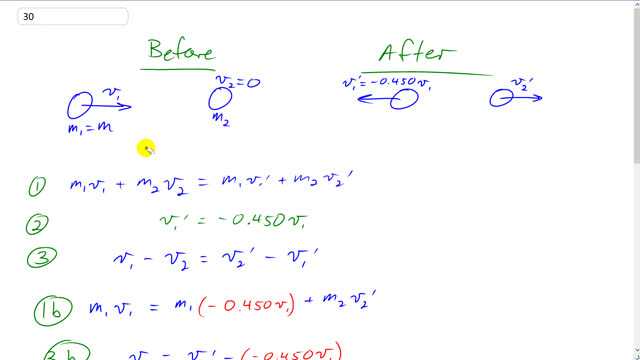
A ball of mass makes a head-on elastic collision with a second ball (at rest) and rebounds with a speed equal to 0.450 its original speed. What is the mass of the second ball?

In order to watch this solution you need to have a subscription.
This is Giancoli Answers with Mr. Dychko. Ball one is approaching ball two with some velocity v 1 and has some mass m 1 equal to m so it's some ball of mass m and it makes a head-on collision which is elastic and ball two is initially at rest so v 2 is zero and after collision, we know that ball one rebounds which means it is going back in the opposite direction in which it was approaching so that's why there's a negative there that negative sign is there because of the word 'rebounds'. And so it rebounds with a speed of 0.450 multiplied by the original velocity that it was approaching with v 1. So v 1 prime is negative 0.450v 1; v 2 prime is some unknown velocity to the right. So we are going to first write down conservation of momentum then we'll write down this little bit of information they give us, the v 1 prime is negative 0.450v 1 and then we'll say since the collision is elastic that means v 1 minus v 2 is v 2 prime minus v 1 prime. So our job is to figure out the mass of ball two in terms of ball one and so we need to do some algebra with these system of three equations and solve for m 2 eventually and so we'll proceed by getting rid of unknown's within our formula until the only unknown we are left with is m 2. And let's rewrite equation 1 by getting rid of this term and because v 2 is initially at rest so it's zero so this term disappears so m 1v 1—this is equation 1, version b— m 1v 1 equals m 1 multiplied by v 1 prime which we know is 0.450 times v 1 so we'll make that substitution and then plus m 2v 2 prime just copied. And then we'll turn to equation 3 in order to eliminate this v 2 prime unknown. So equation 3 we can rewrite by getting rid of this v 2 because it's zero again so we have just v 1 equals v 2 prime minus v 1 prime but we'll put in negative 0.450v 1 instead of v 1 prime. And this negative and negative makes a positive but then we take that positive and then move it to the other side by subtracting it from both sides so that's why we have a minus 0.450v 1 here And so we have v 1 from this side minus 0.450v 1 and then equals v 2 prime and we switch the sides around as well to have the unknown on the left. So v 2 prime is, you know, 1 minus 0.450 which is 0.550v 1. So we'll make that substitution in place of v 2 prime, rewriting this equation 1 again but another iteration on getting rid of variables here; now we are gonna have v 2 prime as the target to get rid of and we are gonna substitute 0.550v 1 in its place. So we have m 1v 1 equals negative 0.450m 1v 1 plus m 2 times 0.550v 1. So v 1 is a common factor for all terms which means we can divide everything by it so it's gone—v 1 is history. So we have 0.550 times m 2, switching the sides around because it's nice to have it on the left since that's the unknown we are solving for m 2, 0.550 times m 2 equals m 1 plus this 0.450m 1 when we move this term to the other side, we have to add it to both sides, and so 1 plus 0.450 is 1.450m 1 and divide that by the 0.550 factor in front of the m 2 there and we end up with 2.64 times m 1 and we are told that the ball is mass m so we'll write just the letter m there; m 2 is 2.64 times m.